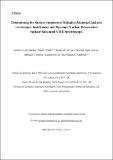Determining the surface structure of silicated alumina catalysts via isotopic enrichment and dynamic nuclear polarization surface-enhanced NMR spectroscopy
Abstract
Isotopic enrichment of 29Si and DNP-enhanced NMR spectroscopy are combined to determine the detailed surface structure of a silicated alumina catalyst. The significant sensitivity enhancement provided by DNP is vital to the acquisition of multinuclear and multidimensional experiments that provide information on the atomic-level structure of the species present at the surface. Isotopic enrichment not only facilitates spectral acquisition, particularly given the low (1.5 wt%) Si loading, but also enables spectra with higher resolution than those acquired using DNP to be obtained. The unexpected similarity of conventional, CP and DNP NMR spectra is attributed to the presence of adventitious surface water that forms a sufficiently dense 1H network at the silica surface so as to mediate efficient polarization transfer to all Si species regardless of their chemical nature. Spectra reveal the presence of Si-O-Si linkages at the surface (identified as Q4(3Al)-Q4(3Al)), and confirm that the anchoring of the surface overlayer with the alumina occurs through AlIV and AlV species only. This suggests the presence of Q3/Q4 Si at the surface affects the neighboring Al species, modifying the surface structure and making it less likely AlVI environments are in close spatial proximity. In contrast, Q1/Q2 species, bonded to the surface by fewer covalent bonds, have less of an effect on the surface and more AlVI species are consequently found nearby. The combination of isotropic enrichment and DNP provides a definitive and fully quantitative description of the Si-modified alumina surface, and we demonstrate that almost one-third of the silicon at the surface is connected to another Si species, even at the low level of coverage used, lowering the propensity for the formation of Brønsted acid sites. This suggests that a variation in the synthetic procedure might be required to obtain a more even coverage for optimum performance. The work here will allow for more rigorous future investigations of structure-function relationships in these complex materials.
Citation
Rankin , A G M , Webb , P B , Dawson , D M , Viger-Gravel , J , Walder , B , Emsley , L & Ashbrook , S E 2017 , ' Determining the surface structure of silicated alumina catalysts via isotopic enrichment and dynamic nuclear polarization surface-enhanced NMR spectroscopy ' , Journal of Physical Chemistry C , vol. 121 , no. 41 , pp. 22977-22984 . https://doi.org/10.1021/acs.jpcc.7b08137
Publication
Journal of Physical Chemistry C
Status
Peer reviewed
ISSN
1932-7447Type
Journal article
Description
We would like to thank SASOL and EPSRC (EP/L505079/1) for studentship funding for AGMR. SEA would also like to thank the Royal Society and Wolfson Foundation for a merit award. PBW would like to thank the Royal Society for the award of an Industry Fellowship. The University of Nottingham DNP MAS NMR Facility used in this research was funded by EPSRC and the University of Nottingham, and assistance from the Facility Manager (Subhradip Paul, University of Nottingham) is also acknowledged. This work was also supported by ERC Advanced Grant No. 320860. The research data (and/or materials) supporting this publication can be accessed at DOI: http://dx.doi.org/10.17630/00533fb3-e938-498d-bfe4-f07d82c309d6.Collections
Items in the St Andrews Research Repository are protected by copyright, with all rights reserved, unless otherwise indicated.

